Rainy seasons can be particularly challenging for homeowners with septic systems. The additional water from heavy downpours can lead to what’s known as hydraulic overload. This happens when your septic system is swamped with more water than it can process or discharge, causing backups and potentially severe damage to your property and the environment.
Understanding the impact of the rainy season on your septic system is crucial. During periods of intense rainfall, the ground becomes saturated, severely reducing the soil’s ability to absorb liquid from the septic drain field. This can lead to the unpleasant and hazardous situation of sewage backing up into your garden or, worse, into your home.
The septic system needs to absorb wastewater properly, especially during heavy rain, to prevent overflow and environmental contamination. To further ensure your system’s readiness for heavy rainfall, consider having your septic tank professionally inspected before the rainy season begins.
Wondering, “How to Fix a Septic Tank that Backs Up when it Rains?” Keep on reading to discover solutions for clogged septic systems!
Quick 5-Step Guide: How to Fix a Clogged Septic Tank During a Heavy Rainstorm
If you’re facing this issue, you need to:
- Inspect your septic system for any existing issues.
- Redirect rainwater away from the septic areas.
- Reduce your household water use during heavy rainfall.
- Ensure regular maintenance and inspection of the system.
- Assess the system post-rain for any potential damage or overflow.
The key to preventing such incidents lies in adequate preparation and timely response. By following the outlined steps and keeping a watchful eye on the state of your septic system, you can mitigate the risks associated with rainy seasons.
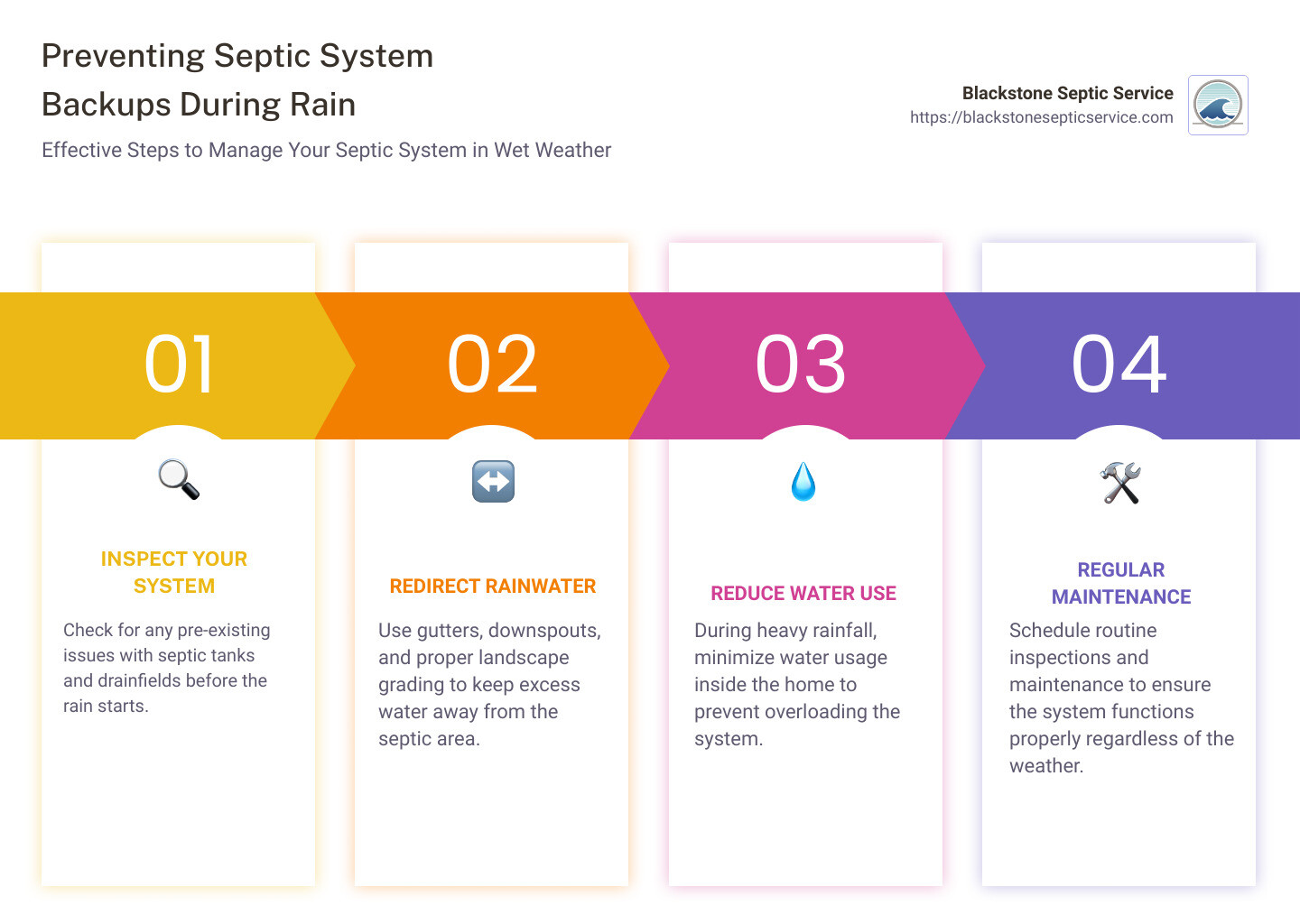
Table of Contents
Step 1: Inspect and Prepare Before the Rain
Before the rain begins, it’s crucial to ensure that your septic system is ready to handle the increased water load. Have your septic tank inspected by a professional to confirm it can handle the extra water and prevent backups and drainfield failure. Preparing in advance can help prevent the system from backing up and causing issues.
Here’s what you need to do: Have your septic tank professionally inspected to confirm it can handle the extra water and prevent backups and drainfield failure.
Septic Covers
Check all septic tank covers and ports to ensure they are securely sealed. This prevents excess water from entering the tank and causing an overflow. If the covers are not fitting properly or if there are cracks, it’s essential to replace or repair them immediately.
Pumping
If your septic tank is near capacity, have it pumped before the rainy season starts. A full or nearly full tank can quickly lead to problems during continuous heavy rains. Regular pumping keeps the tank’s capacity ready to handle additional influx of water.
Water Runoff
Properly directing runoff water is vital. Ensure that rain gutters and downspouts on your home are clear of debris and positioned to channel water away from the septic system, especially the drainfield. This helps in preventing the saturation of the area around the septic tank which can impede the system’s ability to function properly.
Soil Compaction
Avoid driving or parking vehicles on the drainfield. The weight from vehicles can compact the soil, making it less porous and unable to absorb water effectively. Compacted soil is a significant contributor to system failures during the rainy season as it hinders the proper percolation of water through the soil.
By addressing these key areas, you can significantly reduce the risk of septic system backups when it rains. The goal is to keep excess water away from the system and ensure it remains functional and efficient throughout the wet season. Regular inspections and maintenance are your best defense against septic system problems.
Step 2: Redirect Rainwater Away from Your Septic System
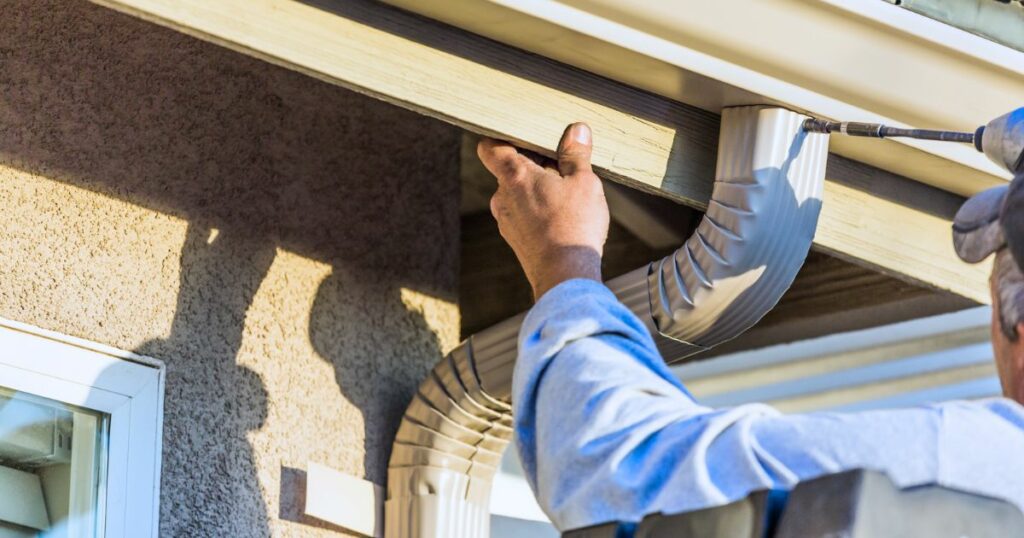
Redirecting rainwater away from your septic system is a critical step in preventing backups during heavy rainfall. Most septic tanks are designed with a specific capacity that can be overwhelmed by a combination of rainwater and wastewater, leading to potential backup and overflow issues.
By managing how water flows around your property, you can significantly reduce the amount of water that reaches your septic system, thus mitigating the risk of hydraulic overload. Here’s how you can achieve this:
Gutter Downspouts
Adjust Your Gutter Downspouts: Ensure that all gutter downspouts are directed away from your septic system. This simple adjustment can prevent a large volume of rainwater from saturating the soil around your septic tank and absorption area. Ideally, downspouts should direct water at least 10 feet away from the septic system. This helps in reducing the risk of flooding the drain field which can lead to backups.
Landscape Grading
Check and Modify Landscape Grading: The slope of your landscape can significantly impact how rainwater flows on your property. It’s essential to ensure that the grading directs water away from your septic system. This might involve adding soil to create a gentle slope away from the system or reconfiguring existing landscaping features to alter water flow. Proper grading helps in preventing water pooling around the septic area, which is crucial during heavy rains.
Drainage Solutions
Implement Drainage Solutions: For properties where water pooling is a consistent issue, consider more structured drainage solutions like French drains or catch basins. These systems are designed to collect excess water and redirect it away from sensitive areas like your septic system. Installing these solutions might require professional help to ensure they are designed and placed correctly for maximum efficiency.
By focusing on these key areas, you can effectively redirect excess rainwater, minimizing the risk of it infiltrating your septic system. This proactive approach not only prevents backups during rainfall but also extends the lifespan of your septic system by reducing potential water damage.
Step 3: Reduce Water Usage During Heavy Rainfall
When the skies open up and the rain pours down, your septic system is put to the test. Heavy rainfall can saturate the ground, making it difficult for your septic system to process the additional water. To avoid overloading your system, it’s crucial to reduce water usage during these periods. Ensuring drains and toilets are functioning properly during heavy rain is also vital to prevent backups, including slow discharge, flooding, and gurgling sounds from drains and toilets.
Household Conservation
Every drop counts when it’s raining heavily. Start by fixing any leaks in your home, whether it’s a dripping faucet or a running toilet. These small leaks can add up to a significant amount of wasted water, which is the last thing your septic system needs during a storm.
- Turn off taps when brushing teeth or shaving.
- Use dishwasher and washing machine only when you have a full load.
Minimize Laundry
Try to reduce the frequency of laundry loads during rainy periods. Consider setting up a laundry schedule that aligns with the weather forecast, doing most of your washing on dry days.
- Wear clothes more than once if they aren’t dirty.
- Batch towels and linens to wash only when necessary.
Short Showers
Taking shorter showers is another effective way to conserve water. Encourage everyone in the household to limit their shower time.
- Set a timer for showers, aiming for 5 minutes or less.
- Install water-saving showerheads to reduce flow without sacrificing pressure.
By implementing these simple but effective strategies, you can significantly reduce the amount of water entering your septic system during critical times. This not only prevents the system from becoming overwhelmed but also contributes to its long-term health and efficiency. Next, we’ll discuss the importance of regular maintenance and inspection to keep your septic system in top condition, rain or shine.
Step 4: Regular Maintenance and Inspection
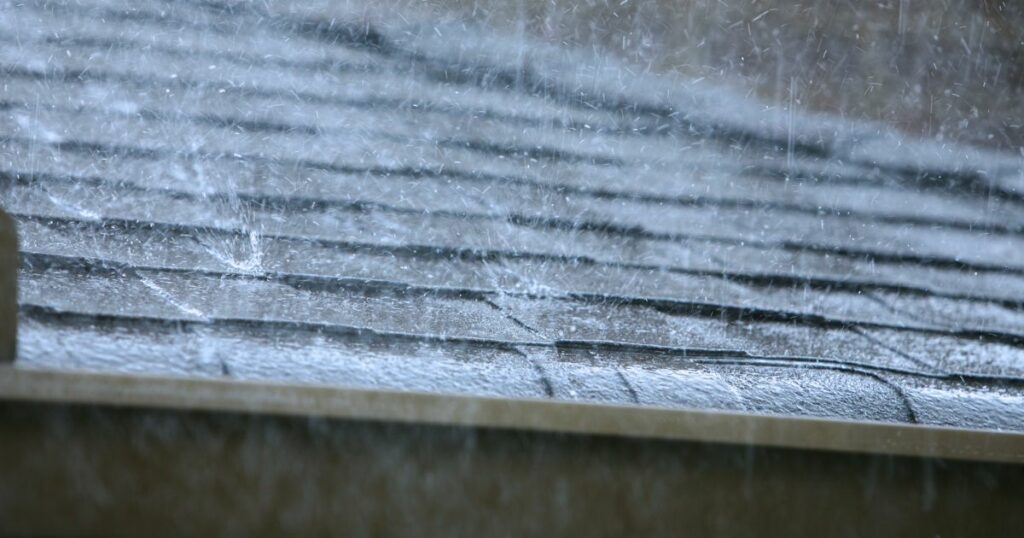
Maintaining your septic system is crucial for its longevity and functionality, especially during rainy seasons when the risk of backup increases.
Here’s how you can keep your system running smoothly: Additionally, ensuring your septic system is equipped with properly installed risers and lids is essential in aiding the system’s ability to treat wastewater effectively, safeguarding against backups during heavy rain.
Pump Schedule
Regularly pumping your septic tank is essential. Pump your septic tank every 3-5 years to prevent solids from overflowing into the drainfield, which can lead to clogs and backups. This schedule might need to be adjusted based on the size of your tank and household water usage.
Baffle Tees
Baffle tees play a critical role in directing the flow of wastewater in your septic system. They prevent the scum layer from exiting the tank and clogging the drainfield. Inspect these tees annually to ensure they are not clogged or damaged. Missing or clogged baffle tees can lead to backups and costly repairs.
Risers and Lids
Installing risers and lids on your septic tank can save you time and money. Risers bring the access point of your tank to ground level, making it easier to pump and inspect without digging. Make sure the lids are securely fitted to prevent water ingress, which can dilute the tank’s contents and disrupt the treatment process.
Professional Inspection
Regular inspections and maintaining components like baffle tees, risers, and lids can significantly extend the life of your septic system and prevent unpleasant surprises during heavy rains. By adhering to a strict maintenance schedule and consulting with professionals like those at Blackstone Septic Service, you ensure your system is robust enough to handle whatever the weather throws at it.
Step 5: Post-Rain Assessment and Recovery
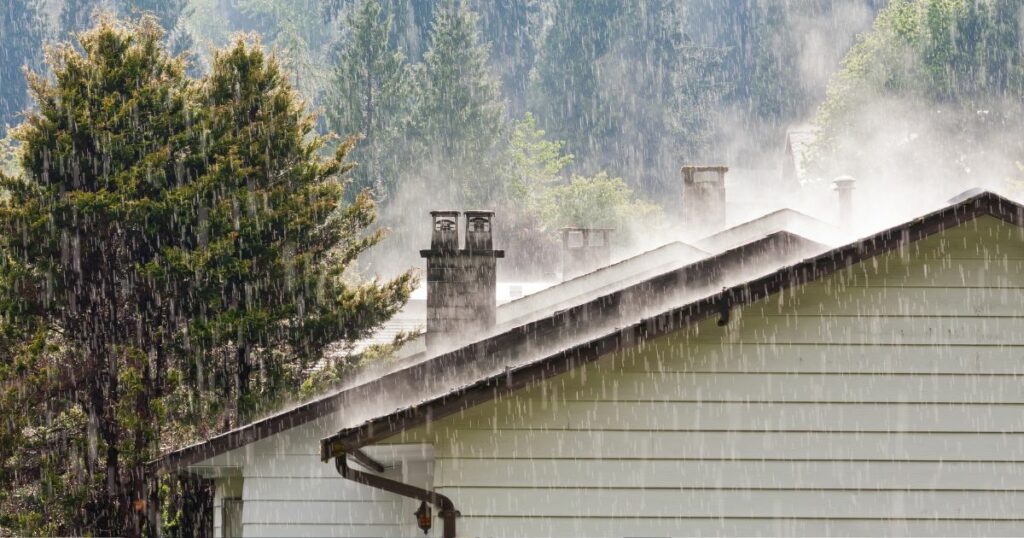
After a heavy rain, it’s crucial to assess your septic system to ensure everything is functioning correctly. This step is vital to prevent future backups and maintain the health of your septic system. Additionally, it’s important to consider pumping the tank to remove any septic waste that may have accumulated due to heavy rainfall, preventing potential backups and overflows.
Drainfield Check
First, inspect the drainfield for any signs of flooding or unusual water pooling. If the weather has been dry and you notice standing water, this could be an indication that your septic tank is not draining properly. A healthy drainfield should not remain soggy or waterlogged after the rain stops.
Contamination Signs
Be vigilant for any potential contamination signs. These can include foul odors emanating from the drainfield area or changes in vegetation health, such as unusually lush or discolored grass. Both can be signs of a septic system that’s not functioning as it should.
Pumping if Needed
If you suspect that your septic tank has reached or exceeded its capacity, it’s advisable to have it pumped. Heavy rainfall can exacerbate existing issues or fill the tank with excess water, reducing its efficiency. Pumping the tank after a significant rain event can help reset the system, especially if there were signs of backup or slow drainage.
Key Actions for Recovery:
- Visual Inspection: Check for obvious signs of system distress like pooling water or sewage on the ground.
- Odor Detection: Sniff around the drainfield and tank for foul smells.
- Professional Assessment: If you’re unsure, it’s always wise to call in a professional from Blackstone Septic Service. They can provide a detailed assessment and suggest necessary repairs or adjustments.
Post-rain recovery is crucial in maintaining the effectiveness and extending the life of your septic system. Regular checks after each significant rainfall can save you from costly repairs and ensure your system is ready for the next downpour. By following these guidelines, you can keep your septic system in top working condition, ensuring it continues to function effectively without impacting your home or the environment.
How to Fix a Septic Tank That Backs Up When It Rains
Identify the Problem
When heavy rains hit, a backed-up septic tank can quickly turn from a nuisance into a serious issue. Identifying the problem early is crucial. Here are the signs you should look out for:
- Backup signs: If water or sewage is backing up into your home, or if you notice pooling water around the drain field, these are clear indicators.
- Slow drainage: Sinks, showers, and toilets that drain slower than usual can suggest a problem in the septic system.
- Foul odors: Unpleasant smells coming from your drains or the area around your septic tank are often the first sign of trouble.
Immediate Actions to Take
If you notice any of the above signs during heavy rainfall, here are some immediate steps to take:
- Reduce water use: Minimize the amount of water going into the septic system. Avoid laundry, dishwasher use, and long showers.
- Check for visible overflow: Inspect the area around your septic tank and drain field for any signs of sewage overflow. This can be a health hazard.
- Safety measures: Ensure that no one comes into contact with any standing water that may be contaminated. Keep pets and children away from affected areas.
Long-Term Solutions
To prevent future issues and fix the underlying problems of a septic system that backs up when it rains, consider these long-term solutions:
- Professional maintenance: Regularly schedule maintenance checks with professionals like Blackstone Septic Service. They can inspect and pump your septic tank, check for blockages, and ensure that all components are functioning properly.
- Upgrade system: If recurrent problems occur, upgrading parts of your septic system, such as installing a larger tank or better drainage solutions, might be necessary.
- Install backflow preventer: A backflow preventer can stop sewage from reversing back into your home during heavy rainfall, which is a common issue during floods.
By taking these steps, you can address immediate issues and work towards preventing future backups. Regular professional maintenance and system upgrades play a crucial role in keeping your septic system resilient against heavy rains. The goal is not just to fix the problem temporarily but to ensure it doesn’t happen again.
Conclusion
By adopting the right preventive measures and committing to regular maintenance, homeowners can effectively manage their septic systems during rainy seasons and avoid the unpleasant and often costly consequences of backups
Choosing the right service provider is crucial. Blackstone Septic Service offers a range of services designed to keep your septic system in optimal condition. Our experienced technicians are ready to assist with:
- Professional inspections to identify and rectify potential issues before they escalate.
- Regular pumping services to prevent sludge buildup and potential backups.
- Expert advice on how to maintain your septic system and prevent common problems.
By following these steps and maintaining regular checks, homeowners can ensure that their septic systems are well-prepared for the rainy season, thus preventing backups and other related issues. A little prevention goes a long way in saving both money and stress in the long run.
Contact us today at Blackstone Septic Service. We understand the challenges that come with maintaining a septic system, especially in areas prone to heavy rainfall. Our team of experts is equipped to provide comprehensive care. Don’t hesitate to contact us for any questions or to schedule a service. We’re here to help you!
Frequently Asked Questions about Septic Systems and Rain
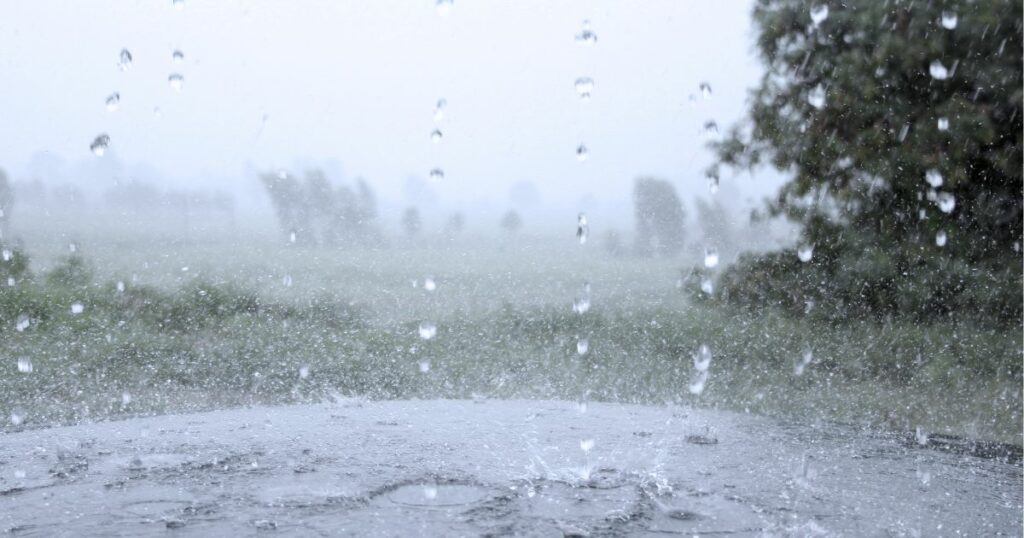
Why does my septic tank backup when it rains?
Heavy rainfall can lead to hydraulic overload in your septic system. This happens because the extra water saturates the soil around your drainfield, making it difficult for water to filter out of your septic system efficiently. When the drainfield is overwhelmed, it can cause the water and waste from your septic tank to back up into your home. This is especially problematic in areas with clay soil or poor drainage, as they do not absorb water well.
How long does it take for a septic drain field to dry out?
The time it takes for a septic drain field to dry out can vary significantly depending on several factors such as soil type, the extent of rainfall, and the condition of your septic system. In general, it could take a few days to a week for the drainfield to recover from light to moderate rain. However, in cases of heavy or prolonged rainfall, it might take longer. Ensuring proper drainage and avoiding water use during this time can help speed up the drying process.
Our Content
Our experienced septic tank specialists have carefully reviewed and edited all of the content to ensure that it meets our high standards for quality and accuracy. At Blackstone Septic Service, our mission is to provide excellent septic services. With a dedicated team of professionals committed to delivering top-tier solutions, we specialize in septic tank system services encompassing everything from Massachusetts septic tank pumping, drain field, and installations for septic tanks.
Customer satisfaction is at the core of our operations, and we pride ourselves on our prompt, reliable, full-service provider and customer-centric approach. Blackstone Septic Service is a family-owned company with highly trained technicians, with over 75 years of experience in septic tanks.



